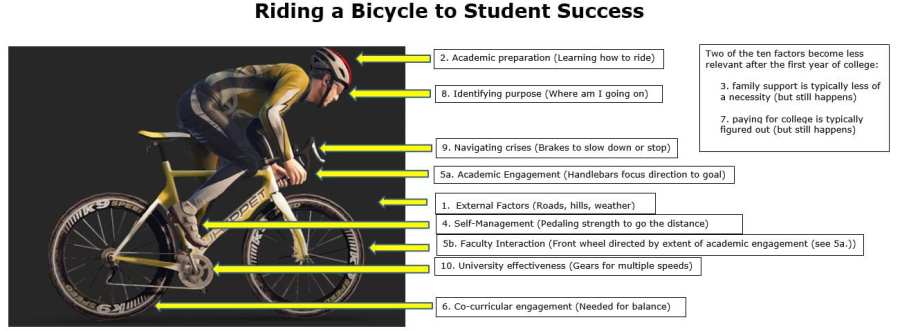Ideally, you will have read Part 1 of this post before before reading this entry. In the first post, the Significant 7 factors for student success before and in the first year of college were introduced.
In this post, we transition in to the sophomore year through graduation for student success. And since the Big 3 Factors (Co-curricular, Academics, Paying for College = CAP) were featured in the first post, this post is framed as…
Beyond the Big 3 – Moving from Tricycle to Bicycle
The Big 3 Factors were symbolically represented by the need to have three wheels to move a tricycle. However, not many, if any, adults, still ride tricycles. Eventually, we are ready for less support and more challenge.
Usually, students become more autonomous in navigating college and their family support becomes less essential to their success. Family support still exists, but less in the “hovering above you” sense. The major shift from a tricycle to a bicycle comes in leaving a wheel behind and learning to balance life on the two remaining wheels. The wheel that is left off at this point, paying for college, is not one that is forgotten, but it typically becomes less of a focus after the way forward is figured out in year one. Tuition is still paid, and part-time work and debt may be needed, but the approach to paying is usually established by year two.
This leaves only the two wheels to ride on: academic and co-curricular engagement. The academic components continues to be guided by the extent of academic engagement and faculty interaction. And co-curricular engagement, while seen by some as less important, is just as necessary to thriving in college – as necessary as a second wheel is to a bicycle. However, there are several new additions to most bicycles versus tricycles. The three major complexities and improvements in bicycles over trikes are described below.
Life is like riding a bicycle. To keep your balance, you must keep moving. Albert Einstein
8. Identifying Purpose – What is the end goal for this bicycle trip?
Although the tricycle may have focused on making it down the driveway and back, bikes are designed for much longer trips. In a similar respect, universities are designed for more than just retention and first year success. Universities are expected to have overarching goals for students and to align students’ education with them. Without these larger goals, universities become more like factories, putting a bunch of parts together (i.e. courses) and stamping it with a trademark (i.e. diploma).
Similarly, students need to know why they are going to college. Many college dropouts become disillusioned with their end goal and with no new plan to guide them, leave. On the other hand, if they discover some purpose for their career or discernment as to their calling, they are more likely to persist through tough times.
Several of the common longer-term goals that help colleges and students identify purpose include:
- Graduate and be hired in a well-paying job
- Go to graduate school to study a passion in more depth
- Find an area of study that leads to a fulfilling job
- Develop a desire for lifelong learning
- Discover a passion for lifelong service and leadership
- Find and build lifelong friendships
9. Navigating Crises – Bicycle brakes help us handle challenges
More often than most people realize, students experience at least one external crisis in college. These challenges, like the death of a grandparent, a parent’s loss of job, or a major health crisis, can result in the journey through college stopping and/or slowing down. In a bicycle, these external crises, like gravel, sharp turns, and pedestrians or cars, are dealt with using the brakes. These situations are often unforeseen and therefore, also, unplanned. From a college’s perspective, helping students through these challenges require resources that reduce the negative impact of crises.
Some of the resources for helping student navigate crises, include, but are not limited to the following:
- Appropriately staffed counseling center
- Comprehensive array of health services
- Campus pastors
- Physical disability services
- Learning accommodations
- Financial aid resources
10. University Effectiveness – Gears allow for multiple speeds
Attending college is more than just showing up to class and taking tests. There are a wide range of other campus resources that are often needed to ultimately graduate. The effectiveness and efficiency of these processes can play a major factor in students’ success. For example, colleges now offer course registration online and have learning management systems for faculty to more education more effective. Universities are creating pathways for students to operate in their highest (or fastest) gear. Colleges do this by understanding life through students’ eyes. When this happens, universities discover efficiencies that can increase students’ ability to progress to graduation. This factor might also be called an effective university culture.
Areas in a university that are often able to improve student persistence and graduation, include, but are not limited to:
- Libraries (access to learning resources)
- Housing (providing comfortable shelter)
- Career Center (guiding job placement)
- Dining (offering nutrition and food
- Registrar (course registration)
- Public Safety (police and security)
- Information Technology (wireless, websites, classrooms)
In short, there are three important factors that lead to students’ success that are often most apparent beyond the first year of college. Their impact may be more subtle than paying the bill or getting a good grade, but without these three factors, many students will neither be satisfied with their college experience nor graduate college.
Beyond the Big Three…
factors that can increase or decrease the speed of the bike, reordered from above result in the acronym UNI
1. University Effectiveness
2. Navigating Crises
3. Identifying Purpose
The acronym here is UNI
which can be remembered by “we perform even better with a uniform on”.
If you have made it to this point, thank you. I hope you have learned something new.
Overall, in this blog post (Part 2) and Part 1, I covered ten major factors that lead to student retention and graduation from college. The picture below captures these ten factors and supposedly learning theory would indicated that by linking the student success factors to components of biking will make it easier for you to remember these ten factors. Click on the image to enlarge it.
A reminder of the factors and their connection to biking
The first four were labelled pre-college factors and tied to the acronym SAFE, and you might say, what makes a student SAFE to go to college. These four factors…
Our ability to pedal the distance – using our Self-management stills
Using our head – preparing to ride – Academic preparation
Help from family to not fall off bike – our Family’s investment in our success at the start
Our knowledge of the terrain – awareness of External challenges may face due to uncontrollable life situations
The next three factors were labelled The Big 3 Factors and tied to the acronym CAP, and you might say, you have to put your CAP to play ball. These three factors included…
Using the two wheels to stay balanced – getting to know and building meaningful relationships with peers and faculty through Co-Curricular and Academic Engagement.
A third wheel needed to get us started – a solid plan to Pay for College
The last three factors were labelled Beyond the Big 3 and tied to the acronym UNI, and you might say, you play even better with a uniform on. These three factors included…
Our bike’s ability to increase our speed – the University’s Effectiveness in operating
Using our brakes – Navigating Crises
Using our eyes – knowing where we are going – Identifying our Purpose









